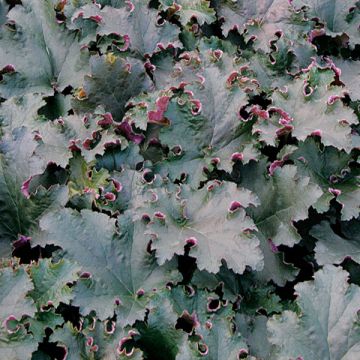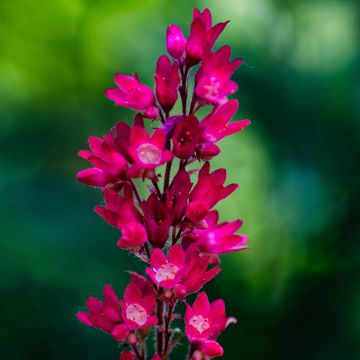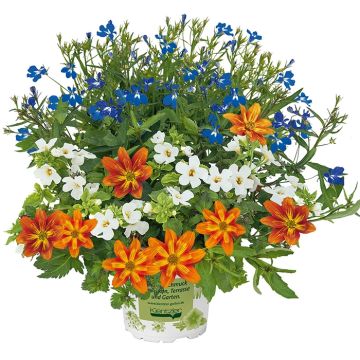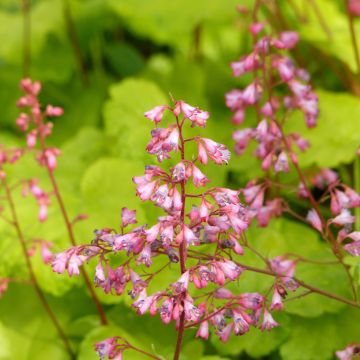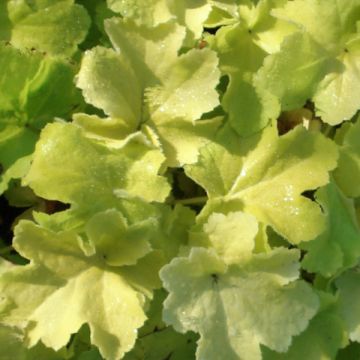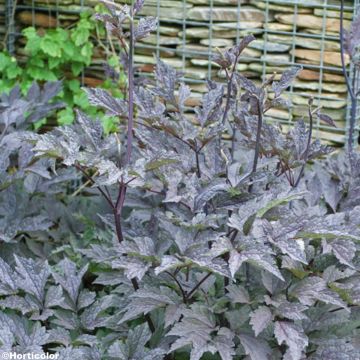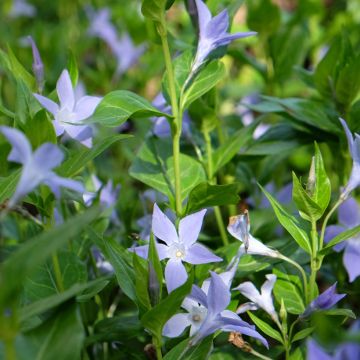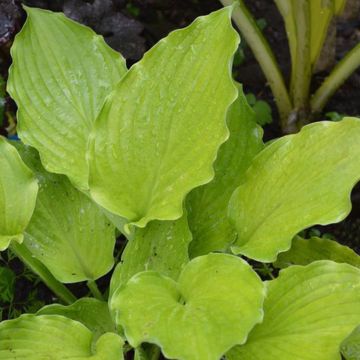

Heuchera Pinky Panky - Heuchère


Heuchère Pinky Panky


Heuchera Pinky Panky - Heuchère


Heuchera Pinky Panky - Heuchère
Heuchera Pinky Panky
Heuchera Pinky Panky
Coral Bells, Alumroot
This item cannot be shipped to the selected country
Delivery charge from €5.90
More information
Schedule delivery date,
and select date in basket
This plant carries a 12 months recovery warranty
More information
We guarantee the quality of our plants for a full growing cycle, and will replace at our expense any plant that fails to recover under normal climatic and planting conditions.
From €5.90 for pickup delivery and €6.90 for home delivery
Express home delivery from €8.90.

Does this plant fit my garden?
Set up your Plantfit profile →
Description
The Heuchera 'Pinky Panky' is certainly a small heuchera, but with a unique and delicate colouration. With a very soft grey-green color, its small lobed leaves are randomly maculated, splashed, and speckled with pink to almost white. In late spring, the plant is adorned with a charming pink flowering carried by slender stems. Even in winter, this plant is decorative and brings life to borders and pots throughout the year. It is a delightful perennial that thrives in semi-shaded areas that are not too dry.
The Heuchera 'Pinky Panky' belongs to the Saxifragaceae family and is a recent horticultural creation by Dirk Scheys. On average, the plant reaches 25 cm (10in) in height (for the foliage) and 30 cm (12in) in width within 3-4 years. This Heuchera forms a small, spreading cushion-like tuft. Its evergreen foliage is the plant's main feature: the leaves are divided into 5 to 7 rounded lobes with remarkably colored ciliate margins. The colour of the leaves varies over time and depending on the exposure. The flowering of this variety occurs in late spring or early summer, between early June and July. Delicate, it takes the form of numerous erect stems, 40 cm (16in) in height, emerging above the leaves. Each flower spike is topped with a panicle filled with multiple small bell-shaped flowers in pink. While it tolerates full shade, the plant will have a more abundant flowering in the morning sun.
The Heuchera 'Pinky Panky', original and precious, is a gem for heuchera collectors. This small plant deserves to be showcased in a beautiful pot or in a slightly shaded area of the garden, near a pathway. Its foliage remains decorative throughout the year, and its flowering adds lightness to any setting. For example, combine it with purple or pink heucheras, the blue blooms of forget-me-not, Omphalodes verna, brunneras, ajugas, columbines, bellflowers, or Japanese grasses (Hakonechloa), always away from the intense sun. Its pairing with daylilies allows for a play of contrasting textures that extends beyond the flowering period. Planted en masse, it will form a remarkable border along an east-facing pathway. In a cool and shaded rock garden, it can be accompanied by tiarellas and heucherellas and asarums, for example.
Report an error about the product description
Flowering
Foliage
Plant habit
Botanical data
Heuchera
Pinky Panky
Saxifragaceae
Coral Bells, Alumroot
Cultivar or hybrid
Other Heuchera
Planting and care
The Pinky Panky Heuchera should be planted early in spring or early autumn, preferably in partial shade, away from direct sunlight. Prepare a planting hole of 20 cm (8in) x 20 cm (8in) x 20 cm (8in). If your soil is heavy, mix some compost with the crumbled soil, partially fill the hole, and place your seedling (after removing the pot) so that the top of the plant's root ball is covered with 3 cm (1in) of soil. Adding a slow-release fertiliser (dehydrated blood, horn powder) will nourish your plant during its rooting period without the risk of burning. Firm the soil and water generously to eliminate any air pockets. If the weather is dry, you will need to water regularly for a few weeks to facilitate the plant's establishment. Also water in summer if drought persists, as Heucheras prefer soils that remain slightly moist. In late winter, Heuchera plants renew their foliage, so we recommend cutting back the previous year's leaves in January or February.
Planting period
Intended location
Care
-
, onOrder confirmed
Reply from on Promesse de fleurs
Shade-loving perennials
Haven't found what you were looking for?
Hardiness is the lowest winter temperature a plant can endure without suffering serious damage or even dying. However, hardiness is affected by location (a sheltered area, such as a patio), protection (winter cover) and soil type (hardiness is improved by well-drained soil).

Photo Sharing Terms & Conditions
In order to encourage gardeners to interact and share their experiences, Promesse de fleurs offers various media enabling content to be uploaded onto its Site - in particular via the ‘Photo sharing’ module.
The User agrees to refrain from:
- Posting any content that is illegal, prejudicial, insulting, racist, inciteful to hatred, revisionist, contrary to public decency, that infringes on privacy or on the privacy rights of third parties, in particular the publicity rights of persons and goods, intellectual property rights, or the right to privacy.
- Submitting content on behalf of a third party;
- Impersonate the identity of a third party and/or publish any personal information about a third party;
In general, the User undertakes to refrain from any unethical behaviour.
All Content (in particular text, comments, files, images, photos, videos, creative works, etc.), which may be subject to property or intellectual property rights, image or other private rights, shall remain the property of the User, subject to the limited rights granted by the terms of the licence granted by Promesse de fleurs as stated below. Users are at liberty to publish or not to publish such Content on the Site, notably via the ‘Photo Sharing’ facility, and accept that this Content shall be made public and freely accessible, notably on the Internet.
Users further acknowledge, undertake to have ,and guarantee that they hold all necessary rights and permissions to publish such material on the Site, in particular with regard to the legislation in force pertaining to any privacy, property, intellectual property, image, or contractual rights, or rights of any other nature. By publishing such Content on the Site, Users acknowledge accepting full liability as publishers of the Content within the meaning of the law, and grant Promesse de fleurs, free of charge, an inclusive, worldwide licence for the said Content for the entire duration of its publication, including all reproduction, representation, up/downloading, displaying, performing, transmission, and storage rights.
Users also grant permission for their name to be linked to the Content and accept that this link may not always be made available.
By engaging in posting material, Users consent to their Content becoming automatically accessible on the Internet, in particular on other sites and/or blogs and/or web pages of the Promesse de fleurs site, including in particular social pages and the Promesse de fleurs catalogue.
Users may secure the removal of entrusted content free of charge by issuing a simple request via our contact form.
The flowering period indicated on our website applies to countries and regions located in USDA zone 8 (France, the United Kingdom, Ireland, the Netherlands, etc.)
It will vary according to where you live:
- In zones 9 to 10 (Italy, Spain, Greece, etc.), flowering will occur about 2 to 4 weeks earlier.
- In zones 6 to 7 (Germany, Poland, Slovenia, and lower mountainous regions), flowering will be delayed by 2 to 3 weeks.
- In zone 5 (Central Europe, Scandinavia), blooming will be delayed by 3 to 5 weeks.
In temperate climates, pruning of spring-flowering shrubs (forsythia, spireas, etc.) should be done just after flowering.
Pruning of summer-flowering shrubs (Indian Lilac, Perovskia, etc.) can be done in winter or spring.
In cold regions as well as with frost-sensitive plants, avoid pruning too early when severe frosts may still occur.
The planting period indicated on our website applies to countries and regions located in USDA zone 8 (France, United Kingdom, Ireland, Netherlands).
It will vary according to where you live:
- In Mediterranean zones (Marseille, Madrid, Milan, etc.), autumn and winter are the best planting periods.
- In continental zones (Strasbourg, Munich, Vienna, etc.), delay planting by 2 to 3 weeks in spring and bring it forward by 2 to 4 weeks in autumn.
- In mountainous regions (the Alps, Pyrenees, Carpathians, etc.), it is best to plant in late spring (May-June) or late summer (August-September).
The harvesting period indicated on our website applies to countries and regions in USDA zone 8 (France, England, Ireland, the Netherlands).
In colder areas (Scandinavia, Poland, Austria...) fruit and vegetable harvests are likely to be delayed by 3-4 weeks.
In warmer areas (Italy, Spain, Greece, etc.), harvesting will probably take place earlier, depending on weather conditions.
The sowing periods indicated on our website apply to countries and regions within USDA Zone 8 (France, UK, Ireland, Netherlands).
In colder areas (Scandinavia, Poland, Austria...), delay any outdoor sowing by 3-4 weeks, or sow under glass.
In warmer climes (Italy, Spain, Greece, etc.), bring outdoor sowing forward by a few weeks.

































